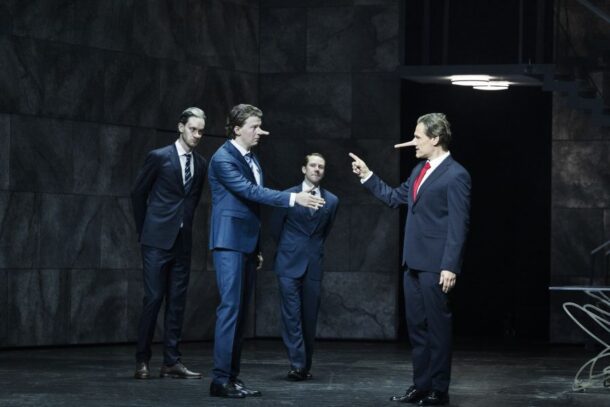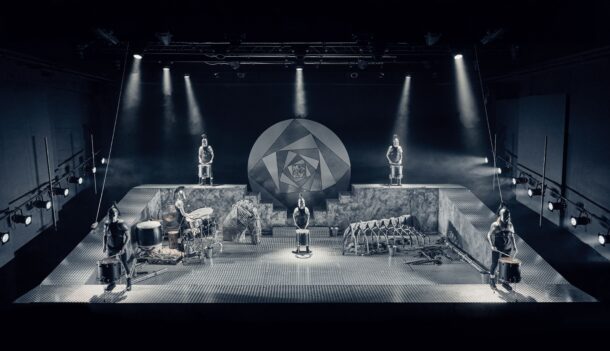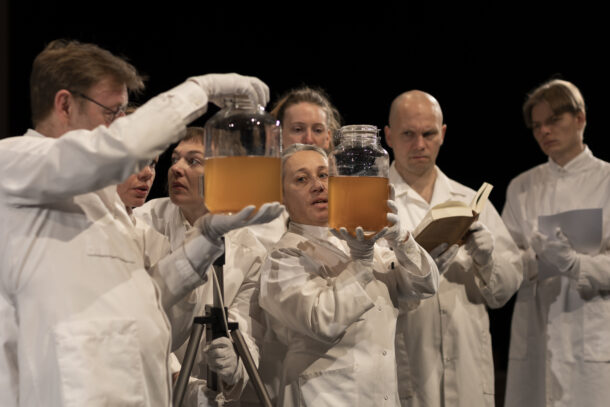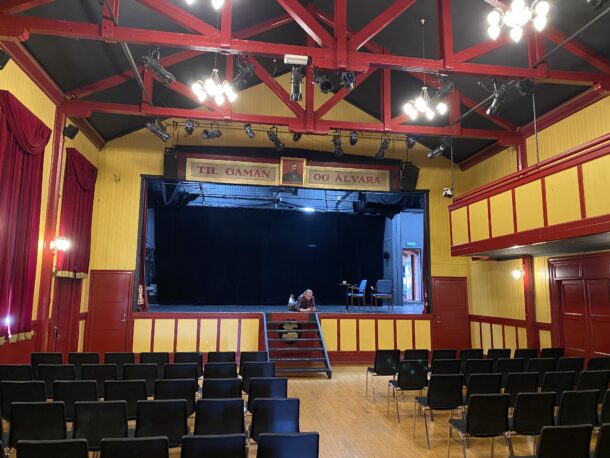by Steve Earnest
As both the Danish and Faroese Theatre systems recovered from the nearly two-year pause of live theatre performances, Copenhagen and Tórshavn saw some movement forward in late Spring and Fall 2022. The strength of the Danish arts system allows for the operation of a system based on shared productions and resources. Additionally, a substantial area of funding exists to support the education and training programs designed to internally create future artists and other trained participants in Denmark, where many Faroese artists choose to continue their training and education in performance. As part of research visits to Tórshavn, Faroe Islands, it was possible to see three works in Copenhagen –The Nose at the Royal Danish National Opera, The Odyssey at the Royal Danish National Theatre and Who Killed Don Calzone? at Tivoli Gardens. The first two works were indicative of the recent state of the National theatre system of Denmark and were both presented in among the highest quality theatrical spaces available in the Western world. Denmark’s vibrant commercial theatre scene was well represented by Don Calzone, which played to sold-out audiences throughout the holiday season. While there were no live works available in Tórshavn during May 2022, however there was a production of (The Mole) during December 2022.

The Nose. Directed by Alex Olle. Photo: Royal Danish National Opera
The Nose, based on Nikolai Gogol’s 1917 short story, was composed by Dmitri Shostakovich in 1927 and revitalized in Spring 2022 by the artistic team of the Royal Danish National Opera. The work is a mammoth undertaking and includes incredibly difficult staffing and scenic demands. The Nose includes over 20 locations (many in fantasy locales) as well as having over 58 named singing roles in addition to a huge chorus. With staging by Alex Olle, assisted by Susana Gomez and scenography by Alfons Flores, The Nose presented numerous challenges as far as interpretation and staging are concerned. Gogol’s fantastic story lends itself to deeply imaginative staging with virtually unlimited possibilities as the major character, a high-ranking official Koviljov, undertakes his daily shave from the barber Jakovlevitj. During the shave, Koviljov’s nose is accidentally severed and the story begins from there. The character of The Nose, played by Gert Henning-Jensen, enacts the actual “separation of the nose from the individual” and begins a stunning dual journey of freedom that represents the escape of “a part from the whole.” A largely dismissed and overlooked work in 1930’s Leningrad, The Nose escaped censorship because it was so poorly regarded by Stalin’s censors. The fantastic romp that is this opera celebrates the escape of the nose from the body of the state official and chronicles the escapades of the nose, including several encounters that involve riots, scenes of police brutality (including a rape) and many volatile events suggesting the strength and supervisory nature of the working class. The power of the Nose was realized in a final scene during which he had risen to a position of power and was surrounded by numerous other big-nosed characters. Revenge was realized in the end as the molested girl returned to dismember the Nose, ending his reign of power. While many of these scenes are not part of the Gogol original, they extend the nature of the story to the fantastic realm afforded by the world of opera.
As is generally the case with Royal Danish Opera productions, the musical spine of the work was impeccable. Realized in Operaen, the master theatre financed by the shipping mogul family Møller-Maersk, there is an affluence of incredible musical talent, both on stage as well as in the orchestra pit. The acting is generally competent at the house – though in my experience not exceptional – but sadly the scenic design at the Royal Danish Opera remains uninspired. The scale of the house is somewhat daunting and on numerous occasions, the design team has failed to provide design work that lives up to the scale of the house. Pedestrian elements like small beds, lamp posts and other smaller realistic units were used in a fantasy world work like The Nose that demanded highly inspired choices; it seemed that the audience was robbed due to the lack of a fantastic world. In many ways the State System of Denmark appears to be somewhat insular, so apparently outside artists are not always included in the realization of works in the major state theatres. As the vision at the Royal Opera evolves, a more expansive approach to theatrical design would be an area ripe for growth.

The Odyssey. Directed by Anja Behren. Photo: Royal Danish National Theatre
Presented in the smaller stage of the Royal Danish National Theatre, The Odyssey told Homer’s epic story in post-dramatic form – five differing perspectives – each looking back with complex interpretations of Odysseus’ journey. The ten-year war had taken Odysseus to the limits of his abilities for human understanding and each of these limits was represented by a different actor in the company. This particular production format mirrored Behren’s 2019 staging of Plato’s Symposium at this theatre that employed a similar ensemble approach that “steps across the divides of gender and generations.” Several of the cast members were graduating students at the Danish National School of Theatre and this work served as something of a showcase production for those new graduates.
The complex staging brought forth a multi-layered “fast track version” of the final war at Troy and dealt with extremely complicated issues such as the reasons for fighting the war, families separated due to the war, the nature of the wartime deaths, hatred among peoples and other extremely violent ideas. Directed by Anja Behren and staged in the smaller Spikhusid, the production began with the audience being admitted to an intense percussive atmosphere with onstage actors, bearing fighting armor and weapons, standing at attention and engaging in pre-military fighting posturing. Percussive instruments were utilized by the entire company and the ensemble established a uniform manner of storytelling from the pre-show onwards. Nathalie Mellbye’s formalistic stage design helped to frame the tight action of the 90-minute frenetic work.
The Odyssey consisted of a mixture of choral sections leading to five or so major character monologues or arias. The major characters each presented an individual story as well as contributing to other elements of the whole and adding movement and sound textures where needed. The five speaking characters at one point each brought buckets downstage and bathed themselves in “blood” as they discussed some of the more graphic details of the war. The careful choreography and nature of the bloody spectacle was incredibly successful and was a testament to the high level of training at the Danish National Theatre School, as several performers were giving their year-end degree performance.
For 40 years the London Toast Theatre Company has presented works at Tivoli Gardens in Copenhagen; from 1998 onward they have presented in the pristine Glassalen, a beautiful glass-encased proscenium theatre seating around 1000 patrons. The original works, written and produced by Vivian McKee, are presented in English and deal with contemporary politics, world issues and other relevant satirical material. The works are presented by a resident company of actors and are staged in an “English Musical Hall” style, using contemporary music, dance and featuring broad contemporary characters. Their show began with a series of highly presentational vignettes led by Vivian McKee, who initially served as a narrator of sorts. A steamy scene was replayed from a past show which could no longer be shown due to the fact that the company lacked an “intimacy coach.” Eventually, the story moved into 1980s Miami, Florida, and the world of organized crime. Don Calzone has retired from the family business, but his successor is an unexpected and unpopular choice. A “Miami Vice” crime team of Crockett and Tubbs began to research the disappearance of Calzone, and all hell breaks out when a drug lord known as the Cuban, a family advisor known as the Danishman and a millionaire businessman known as Donald Dump fight to influence the new Don Calzone. Classic 1980s sketch comedy scenes ensued with a great deal of racy comedy and language (despite the lack of an intimacy coach). Extended wordplay and mispronunciation included a recurring “cook/cock” joke that remained in the story through a journey that led to Mar-A-Lago, and the home of the “all-powerful” overlord, Dump. Dump was played to perfection by South African stage and film actor David Bateson, who also played numerous other characters in the broad comedy. McKee also appeared in numerous cameo roles in addition to her role as leader of the hysterical romp. The work included 15 American songs from the 1980s, with somewhat altered lyrics on occasion (e.g. “Don’t Go Breaking My Balls!”), also propelling the sexy comedic scenes through the fantastic world written by producer McKee. It was noted that the house consistently plays to nearly full or sold-out houses while many venues in Copenhagen have found it difficult to reconnect with audiences in the Post-Covid world.
Unlike its parent country Denmark, the Faroe Islands is a series of eighteen islands that form an isolated nation where most artists receive their formal training abroad. The nation is rooted in artistry and familial custom that generally instills individuals with a strong background in visual arts, music and native dance forms. However, advanced training in forms such as acting, opera and classical dance must be undertaken elsewhere as the nation begins to address the need for a national training system. During May 2022 there were virtually no productions taking place but several works were in rehearsal and stagings were available to be seen due to future touring contracts which are common throughout the Nordic Countries. Considering the connection to Denmark, the Faroe Islands have a Ministry of Culture and arts organizations receive sizeable state funding comparable to other European countries based on their small population. Although the population of the Faroe Islands was only 53,000 in 2021-2022 the funding provided for the arts in the country was around 25 million Danish Kronas, which amounted to around two million Euro. There are numerous theatre companies in the Faroe Islands and other arts organizations who receive state funding based on the type of work that they do. The National Theatre of the Faroe Islands receives around 6 million Krona in annual funding and MAF, the consortium of amateur theatres receives about 1 million Krona. Several professional companies in the Torshavn area receive substantial subsidies on a project by project basis but unfortunately, the nature and sustainability of these companies varies so many are inconsistent in their ability to produce, particularly given the challenges of the COVID years. A large portion of arts funding is also given to the national conglomerate of community theatres, which play an important part in the country’s artistic landscape and provide a great measure of community building and social structure. This funding (as far as theatre is concerned) is controlled by ()an umbrella organization that supervises around 7-12 amateur theatre companies in areas such as Klaksvik, Gøta, Oyrarbakki, Suðuroy and a few smaller theatres largely based in areas near Tórshavn. These companies each apply for yearly funding (generally one project at a time) and receive an amount of several hundred thousand per production, depending on the stated needs and scale of the work. In general, most of the funding is given to a hired professional director, who contracts the necessary production personnel. The beauty of funding in small countries like the Faroe Islands is in the spareness and creativity in the way artistic production and design are achieved. The hiring of skilled personnel such as directors and production leaders is critical as the country moves forward in its level of artistic output. Unfortunately, only a small portion of the funding in the Faroe Islands goes toward training in the arts, and this is an area of exploration and planned advancement for the country.
Tjoðpallur Føroya – the National Theatre of the Faroe Islands had no official productions appearing in May 2022 but rehearsals had already begun for a touring production of Gentumariđ, a pop-horror work presented on the main stage. Written by Faroese playwright Marjun Syderbø Kjelnæs, the production featured two actors, Hans Torgarð and Beinta Clothier and dealt with a woman who returned to her childhood home, her “girl’s room,” after an unsuccessful marriage. The production asked the question “Is the girl’s room a waiting room, a refuge, a trench or a prison?”. The work was scheduled to begin rehearsals in late May 2022 with a planned opening in September of the same year. As the actors were both members of the actor’s union or Council of Faroese Artists, both had scheduled a wage, negotiated by LISA (the Council of Faroese Artists) for appearances in productions. Led by Artistic Director Jenny C. Petersen since 2001, the company presents its works in a smaller 300-seat theatre in the center of Tórshavn. As of December 2022, plans were underway to build a new National Theatre building at the downtown harbor. Renderings and plans had been solicited but no serious movement on the structure had yet begun.
In December 2022 the National Theatre of the Faroe Islands presented Moldvørpłan (The MoleE) on the mainstage of their Tórshavn location. Written by Faroese writer/actor Hans Torgarð (also a main character in the performance), The Mole was produced by Jenny C. Petersen, directed by Icelandic director Guðjón Pederson, and featured a seven-person cast in a broad farce dealing with one of the most prevalent socio-political topics on the islands – the digging of large tunnels to connect the islands. The Faroe Islands have an extensive series of tunnels which nearly connect the entire archipelago but there are more tunnels planned at an exorbitant cost that is contracted out to major Norwegian drilling companies. The Mole centered around the leading character Per, a simple working-class character whose identity has been stolen and who accidentally wanders into the office of the Prime Minister as he seeks help from the authorities. Per becomes mixed up in a number of escapades, including the creation of a set of statues for “Mole of the Year” given to the best tunnel design. The phallic/vaginal nature of the two statues (a perfect fit – one in the other) serves to illustrate the broad sexual antics and politics of the Prime Minister’s office and the tangled web of affairs, swindling of government funds and crazy characters that make up their dysfunctional world. The MoleE was an outstanding success for the company and played fourteen nearly or completely sold-out performances.
Gunnva Zachariasen, founder of the Theatre Company TVAZZ, has developed a record of presenting numerous works at various locations in Tórshavn, locations across Scandinavia and numerous festivals in Sweden, Norway and Denmark. TVAZZ was founded in 2006 by Zachariasen and a number of Nordic artists who wanted to “explore works in a different way…and to test the boundaries of theatre.” One of their initial company works was 4:48 Psychosis that was presented in a mental hospital in Tórshavn in 2007. The Thirty-five audience members each evening were assigned scrubs upon arrival as they sat at medical tables in the mental ward of a Tórshavn hospital. The work was presented in a direct address fashion that confronted the audience directly with Kane’s difficult text. 4:48 Psychosis solidified their mission as a cutting-edge theatre company and catapulted TVAZZ into the conversation as a major Nordic production company. In July 2021, TVAZZ had developed a work entitled Un-tales of Devilry, a play written by Danish playwright Daniel Wedel and based on the 2005 novel written by Faroese author Carl Johan Jensen. For that production, the company had received a major Scandinavian grant in the amount of 750k DKK. Additional funding was raised through the Nordic Culture Point as well as the A. P. Møllerfond.sA collective of artists from Iceland, Norway, Denmark and Sweden were involved. Acclaimed Icelandic director Egill Pallsson worked with Wedel to adapt the novel into a play, that premiered at Nordic house in 2021 and toured to Norway in June 2022.

Un-Tales of Delivery. Photo: TVAZZ
The original production of Un-tales of Devilry was presented at the Nordic House, a prominent culture house in Tórshavn that has become an important location for national, Nordic and international productions. Founded in 1983, Nordic House is located at one of the highest elevated areas in Tórshavn and features numerous internal spaces for lectures, dance and the staging of performance events. The lighting, sound, projection and other qualities are superior to any other space in Tóorshavn and many productions, around fifty different events of various durations per year, are hosted by the house. The Nordic House receives a budget of around 13 million DKK from the Nordic Council of Ministers in addition to a 1.7 DKK stipend from the Ministry of Culture of the Faroe Islands. A relatively small staff of four project managers and three technicians is responsible for the many events at the busy venue.

Interior of Havar Sjonleikarfelag. Photo: Courtesy of the author.
Havar Sjonleikarfelag is the oldest theatre company/building in Tórshavn and has the longest history of theatre production. Basically, a community meeting location and theatre, the house was built in 1910 and has been continually active for over 120 years, aside from the British Occupation of the Faroes from 1940-1945. The house produces a season of theatrical and musical works in addition to hosting numerous companies and various performance events brought in from locations among the Faroe Islands and from abroad. The theatre has a seating capacity of around 250 patrons and has an incredible history of performances during both world wars, as the USA and other Western countries had military operations in the Faroe Islands. There are many stories of clashes between British soldiers and Faroese fishermen over the foreign soldiers’ advances on Faroese women at dances held at the theatre during the occupation. The theatre has hosted many famous U.S. celebrities like Bob Hope, Bing Crosby, and Frank Sinatra.
In addition to the few professional theatres in the Faroe Islands, Glasir, a pre-college secondary school, has emerged with a connection to several professional companies in Tórshavn. As of Spring 2022 a production of Romeo and Juliet was being translated by Faroese writer/actor Hans Torgarð and the work was planned to be presented in April 2023 at the Nordic House. These types of collaborations in the Faroes should emerge as more time is given to research and training in this difficult area of the world. However, with the discussion of the planned building a new national theatre within the next decade, the artistic leaders of the country have a keen interest in the development of some level of national theatre training to further their artistic goals. The country is well aware of its isolated status and has continually engaged in multiple operations to connect with other regions of the world such as Norway, Denmark, Sweden and Iceland.
Steve Earnest received a PhD in Theatre from the University of Colorado, Boulder and an M.F.A. in Musical Theatre from the University of Miami, Florida. Dr. Earnest has published articles, reviews and interviews in Theatre Journal, Western European Stages, Backstage West, Ecumenica, The Journal of Beckett Studies, Theatre Symposium, New Theatre Quarterly, and Theatre Studies, among others. In 1999 he published a book entitled The State Acting Academy of East Berlin and is currently a Professor of Theatre at Coastal Carolina University and is working on projects dealing with the theatre system of Iceland.

European Stages, vol. 17, no. 1 (Fall 2022)
Editorial Board:
Marvin Carlson, Senior Editor, Founder
Krystyna Illakowicz, Co-Editor
Dominika Laster, Co-Editor
Kalina Stefanova, Co-Editor
Editorial Staff:
Asya Gorovits, Assistant Managing Editor
Zhixuan Zhu, Assistant Managing Editor
Advisory Board:
Joshua Abrams
Christopher Balme
Maria Delgado
Allen Kuharsky
Bryce Lease
Jennifer Parker-Starbuck
Magda Romańska
Laurence Senelick
Daniele Vianello
Phyllis Zatlin
Table of Contents:
- AVIGNON 76. A Festival of New Works by Philippa Wehle
- Almodóvar’s Women on the Verge in Portugal by Duncan Wheeler
- BRACK IMPERie. About “Hedda Gabler” by Vinge/Müller at Norske Teatret Oslo by Thomas Oberender
- Embodied Intimacy: The Immersive Performance of The Smile Off Your Face at Edinburgh by Julia Storch
- Fear, Love, and Despair – Radu Afrim: Director of Core Feelings by Alina Epîngeac
- Grec Festival de Barcelona, July 22 by Anton Pujol
- I Think of Curatorial Work in Scholarly Terms: An Interview with Ivan Medenica by Ognjen Obradović
- New Worlds Revealed in an Immigrant Journey, and an Unexpectedly Meaningful Universe Discovered and Destroyed Inside Styrofoam, at the Edinburgh Festival by Mark Dean
- Participation, Documentary and Adaptation: Barcelona Theatre May 2022 by Maria Delgado
- Report from Berlin, April 2022 by Marvin Carlson
- Report from Berlin (and Hamburg….) 5/2022 by Philip Wiles
- The Sibiu International Theatre Festival Transforms Dreams into Reality (The Magic of 2022 FITS in Short Superlative) by Ionica Pascanu
- Theatre in Denmark and The Faroe Islands – Spring 2022 by Steve Earnest
- The Polish Nation in a Never-Landing Aircraft by Katarzyna Biela
- The Piatra-Neamt Theatre Festival in Romania: 146 Kilometers from Heart to Heart by Cristina Modreanu
- Will’s Way at the Shakespeare International Festival Craiova 2022 by Alina Epîngeac
- Interview with the Turkish theatre critic Handan Salta on TheatreIST by Verity Healey
www.EuropeanStages.org
europeanstages@gc.cuny.edu
Martin E. Segal Theatre Center:
Frank Hentschker, Executive Director
Marvin Carlson, Director of Publications
©2022 by Martin E. Segal Theatre Center
The Graduate Center CUNY Graduate Center
365 Fifth Avenue
New York NY 10016
European Stages is a publication of the Martin E. Segal Theatre Center ©2022


